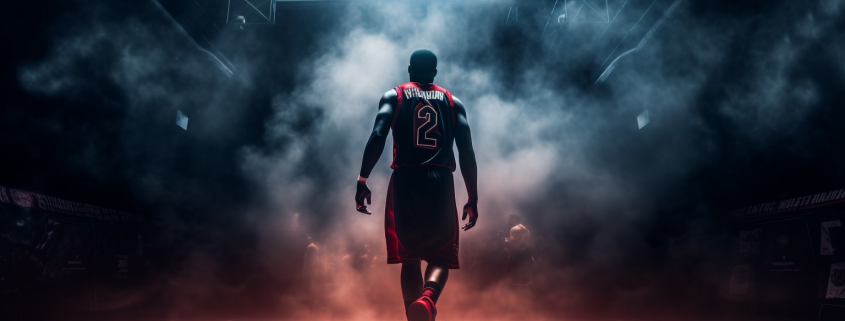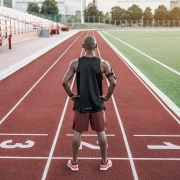What is Visualization in Sports?
“When I train, one of the things I concentrate on is creating a mental picture of how best to deliver that ball to a team-mate, preferably leaving him alone in front of the rival goalkeeper. So what I do, always before a game, always, every night and every day, is try and think up things, imagine plays which no one else will have thought of, and to do so always bearing in mind the particular strengths of each team-mate to whom I am passing the ball. When I construct those plays in my mind, I take into account whether one team-mate likes to receive the ball at his feet, or ahead of him; if he is good with his head, and how he prefers to head the ball; if he is stronger on his right or his left foot. That is my job. That is what I do. I imagine the game.”
– Ronaldinho, Professional Football Player.
Back in 2006, Ronaldinho, who played for FC Barcelona and his home country Brazil at the time, was interviewed on how he used imagery before the world cup in a piece for the New York Times Magazine; the above quote was his response [1]. It’s an excellent — and real — example of how Elite athletes use visualization in sports.
This blog post will explain what visualization is in sports, what it’s used for, more real-life examples, and tips to get started.

What is visualization?
Visualization involves creating vivid mental images of performance. For example, that could be something as simple as a pass, a free kick, a free throw, or a successful swing in golf. Practicing visualization and mental skills can help increase self-confidence, reduce anxiety before competition, and improve overall performance [1,2].
But why is mental imagery so powerful? When done correctly, visualization activates neural pathways in the brain — the same pathways that are activated during physical performance. Regular visualization practice can help strengthen these neural pathways to improve performance and lessen anxiety (alongside many other benefits discussed below).
What are the benefits of visualization in sports?
We’ve highlighted several benefits of mental imagery and visualization already, but other benefits include:
- Improve confidence & focus
- Reduce anxiety
- Optimize muscle memory
- Build mental toughness (visualize overcoming mental obstacles)
- Improve goal setting
Visualization might also prove to be an effective mental skill for injured athletes. These athletes can mentally rehearse performance (even though they can’t play) and use visualization and other mental skills to set goals to help with their recovery.
There’s a reason why the best athletes use visualization — so why shouldn’t you do the same? Add visualization exercises to your training and see how it can improve your performance and mental preparation for competition.
And once you’ve got the hang of visualization, why not move on to other mental skills?
Related: How to Create a Mental Training Program for Athletes.

Examples of mental imagery
“Visualization lets you concentrate on all the positive aspects of your game.” – Curtis Strange, American Professional Golfer.
Mental skills and visualization are only becoming more popular. In recent years, every sports team has invested in a psychologist — or a team of psychologists — and athletes can be found practicing a cocktail of mental skills before practice.
So we’ve gathered together other examples of mental imagery and visualization, one from an Olympic gymnast and another from Tiger Woods. Let’s hear from Makalya Stambaugh, a 6x Olympic junior gymnastics champion:
“Visualization is something I use to calm my nerves. I did something like that before, but when I came to Oregon State, they really helped me hone in on those skills of actually picturing the bar routine, the movement, and think the exact same thoughts you would be doing it. That makes me more prepared and confident when I compete.”
And now, let’s talk about how Tiger Woods uses visualization — a skill he’s practiced since the very beginning of his career, taught when he was a boy by his Father. In the below clip, you can see how Tiger describes putting like taking a series of pictures and how this helps him visualize a successful shot.
How to get started
So, now that you know Elite athletes apply visualization techniques to their sport, how can you get started?
We’d suggest keeping it simple to begin with. Before practice, focus on a skill you want to improve, whether that’s passing, shooting, putting, cornering, or whatever it may be. Visualize successful skill performance — what technique needs to happen to produce a successful outcome?
Imagine that, and if you’re off to a great start. Then, practice often and focus on different areas of your game to improve.
Take notes on how you feel and what effect you think it had on performance, anxiety, and confidence, and adapt from there. And while we would recommend practicing with a psychologist, the beauty of visualization and other mental skills is that they can be done anywhere by everybody… whether a junior high school football player or an Elite gymnast.
Related: How to Use Visualization to Support Sport Performance.

Use Rewire to improve your mental performance
Visualization is one of many mental skills that can help improve performance, reduce anxiety, and help athletes prepare for competition.
Athletes can also use Rewire neuro-science training protocols to build other mental skills, to improve resilience and focus, and reduce anxiety and stress in the lead-up to competition.
And, if you’re a coach, you can monitor your athlete’s readiness score — an aggregate score based on cognitive, physical, and emotional wellbeing — to better tailor performance, prioritize recovery, and get the most out of each athlete.
“Rewire’s latest platform makes mental strength training more accessible to athletes everywhere with easy-to-use tools to help them reach their goals.”
– NBA All-Star, Kyle Korver
Find out how Rewire can help you
FAQs
What does visualization mean?
Visualization is all about creating mental images and imaging specific scenarios. Athletes practice visualization to improve performance and confidence, and to reduce anxiety before competition.
How does visualization improve performance in sports?
Visualization can improve confidence, reduce anxiety, and improve skill-based performance, e.g., passing or shooting the ball.
What is an example of visualization in sports?
A golfer might imagine putting the ball — the direction it will go and how much power to apply to improve putting performance.
References:
- Cumming, J. and Ramsey, R., 2008. Imagery interventions in sport. In Advances in applied sport psychology (pp. 15-46). Routledge.
- Halvari, H., 1996. Effects of mental practice on performance are moderated by cognitive anxiety as measured by the Sport Competition Anxiety Test. Perceptual and motor skills, 83(3_suppl), pp.1375-1383.












